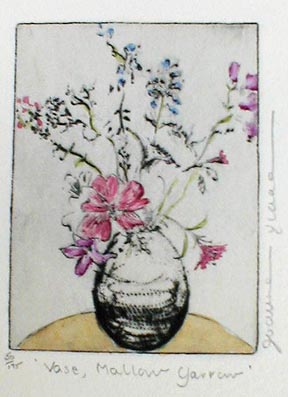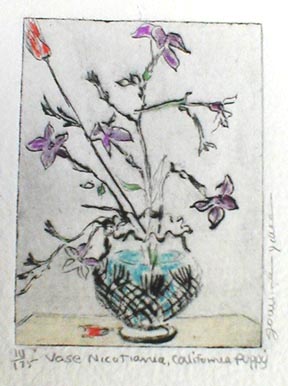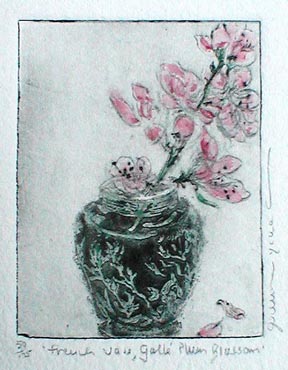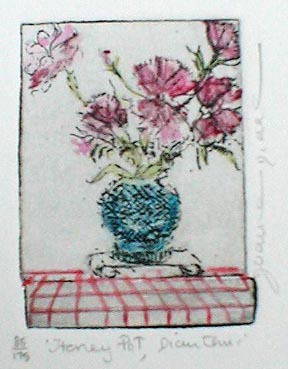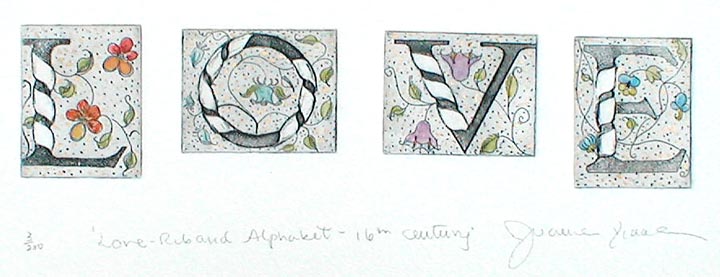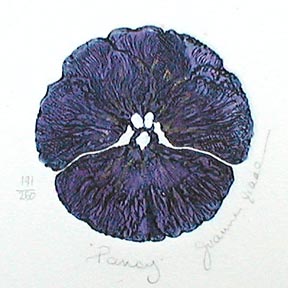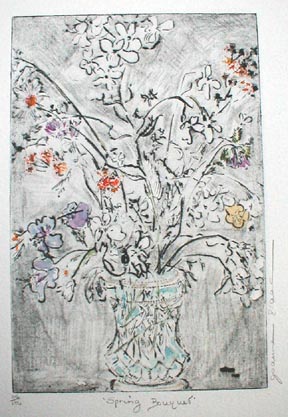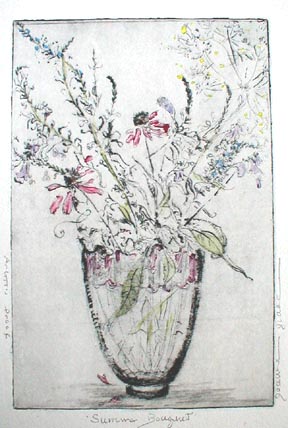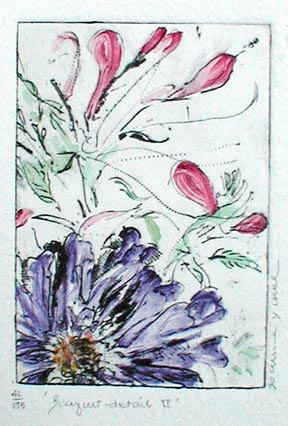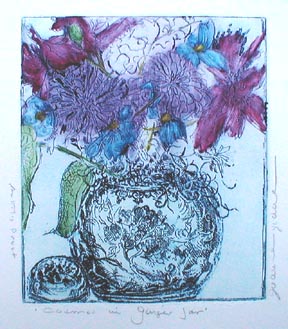|
Like mother, like
daughter: sharing a commitment to art
By Diana Loercher, Special to The Christian Science
Monitor JULY 28, 1983
APPLEBACHSVILLE, PA. — The son following in his
father's footsteps is a historical cliche, but a
tradition of daughters following their mothers further
than the kitchen is barely in the making. As more and
more mothers pursue careers, however, they are serving
as models for their daughters and passing the torch to
those eager to run with it.
Artist Joanne Isaac lives with her husband, Charlie,
and her daughter Rachel, who is also an artist, in a
classic Bucks County stone farmhouse in the
picturesque wilds of Applebachsville (near
Quakertown), where she has created the significant
body of her etchings. Mrs. Isaac's work is found in
the collections of UNICEF, the United States
Department of State, the US Embassy in Paris, the
Honolulu Academy of Arts, and the New York Public
Library, among others. She has exhibited widely
throughout the country and attracted an enthusiastic
following among those who appreciate her delicate
mastery of the etching medium and her scrupulously
faithful renderings of flora and other scenes from
nature. Equally popular is her series of Pennsylvania
Dutch barns.
Mrs. Isaac is the mother of four grown children. Two
daughters and her son live away from home. Rachel, her
second daughter, moved back home last year. She
returned at her parents' urging, because they felt she
had demonstrated the potential, while studying etching
at Penn State and cultivating the medium after
graduation, to become a professional artist.
Rachel set up her own studio in a separate wing of the
farmhouse and sold enough etchings last year to live
modestly on the income from her art. There they sit,
mother and daughter, in that pastoral woodland,
scratching their designs onto metal etching plates,
bathing them in acid, inking them, and rolling them
through the press. They borrow each other's acid,
criticize each other's work, disagree about business
practices, and share the special intimacy of a mutual
discipline.
They resemble each other, too, like a doe and her
fawn, with Rachel a shyer and gentler version of her
mother. Slender, and graceful in their movements, both
exude intensity and energy. Their work is strikingly
similar as well. Rachel's depictions of flowers seem
at times almost indistinguishable from her mother's,
with the same daintiness of line and sensitivity of
perception. But there are also differences. Rachel's
work often features animals, and there are anomalous
prints here and there that suggest an individuality
groping for its own unique expression, possibly in an
abstract or expressionist idiom.
Recently we sat together around the dining room table
in the farmhouse, looking through portfolios of their
etchings and exploring tentatively, at times warily,
the connections between the two women as mother and
daughter and as artists.
Mrs. Isaac begins by describing her own upbringing:
''I was raised in a very traditional way - the
European approach: It's better to get married early
and produce children. Stay married at all cost and
life will be simple. My dad was the great provider. My
mother was the great homemaker. What could be better?
''Her work was in the home. She was our mother,''
continues Mrs. Isaac with a wry laugh. ''But she did
paint. I have some of her art upstairs, and it's very
charming.''
Mrs. Isaac describes her parents as very happy and
very much in love. But there's a tinge of bitterness
about her mother's unfulfilled potential.
Her own marriage developed in quite a different way.
She states emphatically: ''The most fortunate thing
that happened to me in my career was my husband. He
encouraged me. He was not the kind of husband who
would come home and say, 'Where's my shirt?' or 'Why
didn't you do this or that?' He does plenty himself.''
How did Mrs. Isaac manage to juggle the conflicting
demands of her vocation and her four children? She
responds with surprising aplomb:
''It was the easiest of things to do, because I was in
the house. The etching medium is an easy one to work
in because the plate doesn't dry, so I could stop and
come back to it if I had to. Frankly, it was a lot
easier than going to work. I have thought of putting
the studio out in the barn, but now I have the
privilege of racing through the house and putting the
wash in the machine. I might get a little ink on it,
but I can function.''
When her children were small, she also relied on baby
sitters and household help once or twice a week so she
could maintain a work schedule. But how did she manage
to satisfy the needs of her children?
Mrs. Isaac answers thoughtfully, ''Well, maybe I
wasn't the world's greatest mother.'' And she grants
that, if she had it to do over, she would spend more
time with her children. ''I always enjoyed my
children, I really did. I didn't like to drive and
chauffeur, and I think they knew that. There had to be
some measure of sacrifice on everyone's part. I didn't
do everything I should have done, but I didn't ignore
everything, either.''
Her children, she adds, have not only enriched her
life but provided the inspiration for some of her
work, particularly in their early years.
But she confides: ''After I had my first child, I
thought my (professional) life was over. It didn't
take me more than a few days to discover that I had to
have a form of expression. It became obvious that I
had to do something that was of value to me.''
And what of Rachel? What was it like for her and her
brother and sisters to grow up with a mother who was a
committed artist? Mrs. Isaac volunteers that Rachel
once said, '' 'One thing you can say about Mommy is at
least she doesn't bother you.' . . . Paul (the son)
said he would never marry an artist, and Rachel said
she would never be an artist. When you watch somebody
smushing in ink all the time downstairs in the
basement, which was where my studio was in the other
house, it doesn't look too romantic.''
Rachel responds, equivocally at first: ''I don't think
we really thought about Mother being an artist. That's
just how it was.''
But later, when her mother leaves the room to answer a
phone call, she confides: ''The only thing I regret is
that it seems that other mothers were really wrapped
up in their children, like their children were their
whole life and their children's welfare was more
important than theirs. Mother was not like that at
all. She cared about everything about us, but she
cared just as much about what she was doing, so it was
different from having your mother wrapped around you
and involved in what you're doing all the time.''
Does Rachel plan to combine career and family?
''Definitely no children,'' she says. ''I really feel
that. Well, if somehow I made enough money so that I
could take care of one child, maybe.''
''I would like to get married,'' she admits. ''I don't
want to be alone for the rest of my life, but if I
have to, I'll be happy.''
Rachel is somewhat overwhelmed by the demanding if not
the exclusionary nature of the commitment to art, but
she seems to have her mother's grit and determination.
She needs it, because there is another major conflict
she has to overcome - that of being compared with her
mother. At Penn State she was criticized for imitating
her mother, having an unfair advantage because of her
mother, and depicting her mother's ''trite'' subject
matter.
''People are always saying, when they see my work and
my mother's portfolio, 'Oh, she'll never be as good as
her mother,' '' Rachel says. ''I don't like being
compared. But I don't worry about it anymore, because
I don't think it has anything to do with me. I have a
sense of my own self that people don't give me credit
for. Sometimes I have to stop and think, What are they
talking about? It's a whole other person they're
talking about. It makes as much sense to compare me to
Picasso.''
Mrs. Isaac points out: ''You have to realize that
people compare me to you, too: 'That looks like what
yours must have looked like when you were young.' ''
''I have absolutely no feelings of competitiveness at
all,'' Rachel concludes. ''I'm not a competitive
person.''
''Except,'' Mrs. Isaac notes, ''when we run out of
acid.''
|
